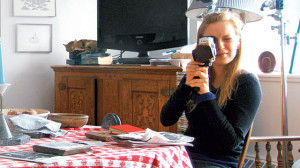Fruitvale Station
Ryan Coogler’s recreation of Oscar Grant’s last day before he was shot in the back by a panicky BART cop on the Frutivale platform on an otherwise ordinary New Year’s Eve, is, among its many virtues, a terrifically nuanced character study. In one bravura sequence, Oscar (a marvelous Michael B. Jordan) plays with a stray dog while he fills up at a gas station. No one’s around to see this brief interaction, or to witness Oscar’s grief after a car hits the animal and speeds away. As depicted in this essential film, sudden death and helpless anguish are part of everyday life in Oakland.

Stories We Tell
Stories We Tell
Canadian actress (The Sweet Hereafter) and director (Away From Her) Sarah Polley plumbs her family history in this unusually thought-out first-person doc. The mystery at the core of the film revolves around Polley’s deceased mother, and the glimpses we get of her in numerous home-movie snippets (pay close attention, for they aren’t necessarily what they appear to be) don’t draw us closer to a resolution so much as suggest the impossibility of ever knowing another human being.

Museum Hours
Museum Hours
Jem Cohen’s understated yet profound film imagines an ad hoc friendship between a 60-something security guard at Vienna’s Kunsthistorisches Art Museum and a slightly younger Canadian tourist who finds herself at loose ends during an extended visit to a comatose friend. The movie’s central theme is the tenuous hold of civilization at present, evoked through myriad verbal and visual contemplations of paintings and buildings. Johann and Anne are standing in a nondescript gravel parking lot late in the film, with the camera at a discreet distance, when she gets a call from her friend’s doctor. Johann steps away, allowing Anne a private moment when she gets off the phone. The filmmaker likewise gives Anne her space. Awareness and compassion are as much hallmarks of civilization as works of art and architecture.

Gravity
Gravity
Simply mentioning the title of Alfonso Cuaron’s adrenalized space oddity is enough to summon an image or a sequence. What popped in your head? I propose the seemingly unremarkable moment in the film’s opening minutes when our perspective seamlessly shifts from third person (watching Sandra Bullock and listening to her breathing) to first person (the view from inside her helmet, of scrolling numbers and a gyrating skyscape). Regardless of what you think of the story and the characters, Gravity is top-drawer filmmaking.

Kill Your Darlings
Kill Your Darlings
Period pieces are notoriously hard to pull off on an indie-film budget, but that’s a minor hurdle compared to crafting a convincing portrait of well-known historical figures. Daniel Radcliffe’s marvelous portrayal of Columbia University freshman Allen Ginsberg circa 1944, under the sway of first love Lucien Carr, uninhibited writer Jack Kerouac and certified freak William Burroughs, finds its zenith in a single close-up late in the film. David Kammerer, Lucien’s mentor and lover (and Allen’s ostensible rival for Lucien’s affections) desperately pressures Ginsberg to confide where Carr has gone. Without a word, Radcliffe conveys resentment, self-interest, confusion and, finally, empathy. On second viewing, it’s even clearer that the film, and Ginsberg’s subsequent path as a human being, pivots on this moment.

12 Years a Slave
12 Years a Slave
Saved from a lynching by the plantation overseer, Solomon Northrup is nonetheless left to learn his lesson at the end of the rope. His toes barely reach the muddy earth, and after hours of avoiding strangulation he’s exhausted and dehydrated. The scene has many stages and meanings, but the most revelatory and shocking aspect is the way the other slaves ignore Solomon (or are so practiced at survival mechanisms that they don’t register his suffering). The cruelly dehumanizing effects of slavery are more subtle and devious than I ever realized.

Blue Is the Warmest Color
Blue Is the Warmest Color
As one might expect from a study of an unformed young woman becoming, well, slightly less unformed, Blue Is the Warmest Color delivers a peripatetic stream of intense feelings, intellectual inconsistency and pervasive ambiguity. The image that stays with me, and it could be from any of 20 places in the film, is of Adele’s perplexed countenance. Adele (a brave and generous Adele Exarchopolous) might be trying to make sense of how she fits (or doesn’t) with her school friends, or how to respond to her unexpected feelings of attraction to other women, or how to make and keep her older lover, Emma (Léa Seydoux), happy. Like us, Adele is sussing out her way through a movie comprised of questions rather than answers.

Inside Llewyn Davis












